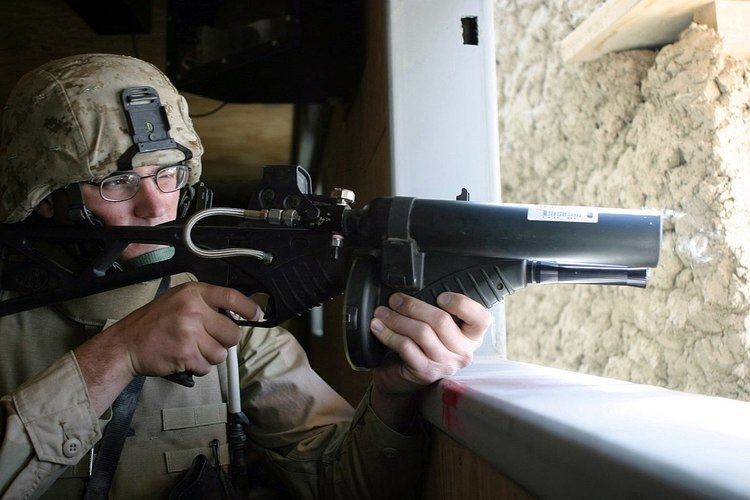Used by See Users Produced 2003 - present | ||
 | ||
Wars Afghanistan WarIraq WarLibyan Revolution2013 Lahad Datu standoff | ||
The FN 303 is a semi-automatic less-lethal riot gun designed and manufactured by Fabrique Nationale de Herstal. The FN 303's projectiles have been specifically designed to break up on impact, reducing risks of penetrating injuries. Typical operating scenarios include domestic violence intervention, marking violent suspects and building surveillance.
Contents
Overview
The FN 303 uses compressed air to fire projectiles from a 15-round drum magazine. It is designed to incapacitate the target through blunt trauma without causing critical injuries, and is most widely used for riot control and other kinds of combat where lethal weapons should be avoided.
The 303 can be fired from the shoulder using adjustable iron sights, or it can be mounted in an under-barrel configuration on most assault rifles when its stock assembly is removed (in this configuration, it is designated M303). It also comes with a top-mounted Picatinny rail that can fit most commercial weapon accessories, such as telescopic sights, laser sights and tactical lights. FN markets its own set of accessories for the launcher, including tactical vests, slings, carrying bags, and gas compressors. It is accurate at distances up to 35 metres (38 yd).
History
The FN 303 is based on a project by the Monterey Bay Corporation designated the XM303. The development team consisted of designers and researchers from two paintball related design and manufacturing firms, including Airgun Designs. The prototype was named the UBTPS, Under Barrel Tactical Paintball System.
The design could be attached to an M16 rifle and was conceived as a less-than-lethal weapon system coupled with a lethal weapon system, providing a wide range of response capabilities that were immediately available. A stand-alone version was also developed.
The UBTPS also featured a rotating barrel magazine, allowing for a wide range of different projectiles to be available and selectable without the need to change magazines.
Also developed was a bismuth-weighted projectile to provide the necessary mass, allowing the UTPBS to achieve the engagement range requirements.
Ammunition
The FN 303 fires a spherical, fin-stabilized projectile. According to FN, the fin-stabilized design provides greater accuracy than a standard paintball round. The forward half of the sphere is a non-toxic granulated bismuth shell designed to fragment on impact to prevent penetration damage. The rear half of the sphere contains one of several color-coded liquid payloads:
The mass of the projectile is 8.5 g (131 gr), providing a muzzle energy of 31 J (23 ft·lb).
Safety
In 2004 in Boston, USA an FN 303 round killed Victoria Snelgrove when it struck her in the eye, causing her to bleed out before medical assistance arrived. Subsequent tests by Boston Police indicated that the 303's accuracy "decreased significantly" after about three hundred firings. This is circumstantially corroborated by testimony of the officer who fired the weapon, stating that he was aiming at a rioter throwing bottles and did not know that a bystander had been hit. A 15 million USD wrongful death lawsuit against the City of Boston and FN Herstal was settled in July 2006. In 2007 the Boston Police destroyed their remaining FN303s, stating they were more powerful and lethal than had been anticipated.
During violent protests in front of the ARCELOR building in Luxembourg city on 11 May 2009, the weapon was used for the first time by local police. An RTL cameraman was hit in the hand, breaking one finger.
During Independence day riots in Finland on 6 December, police used FN 303 against rioters, who were participating in a protest against the Independence Day celebrations. One anarchist was injured in the eye from bismuth shells.
